Pre-hydration is Effective for Rapid Control of Wayward Atopic Dermatitis

Pre-hydration is Effective for Rapid Control of Wayward Atopic Dermatitis
INTRODUCTION
Educating sufferers and households on proper skin care stays
a key factor in atopic dermatitis (AD) control. Published remedy
recommendations for the control of AD propose the usage of mild cleansers and
the frequent utility of emollients.1,2 Surprisingly, there are absolutely no
facts available to manual recommendations on most effective bathing practices.
Some resources advocate daily bathing for sufferers with AD, even as others,
especially within the pediatric realm, have advise proscribing baths to a few
times weekly.Three
Bathing practices are in all likelihood to seriously
influence disease control in AD. On one hand, extended or repetitive contact
with water can harm the pores and skin barrier, theoretically worsening the disorder.Four,5
Conversely, water touch may be beneficial by using hydrating the stratum
corneum, taking into account enhanced stratum corneum uptake of topical
corticosteroids (TCS).6 In our exercise, we've long applied bathing for 15–20
mins followed by way of TCS utility as a way for inducing clearance of even the
most extreme disorder in the course of the preliminary patient visits.7
Patients are told to use the ointment inside 3 mins of having out of the bath
bath after a quick “pat dry.” While
research have proven this “soak and smear” method may additionally have
utility in a diffusion of dermatoses, this method has no longer been
systematically evaluated in a population of patients with AD.7–11 The goal of
the current observe was to determine the effectiveness of the pre-hydration
technique combined with topical steroid therapy in attaining disease control in
sufferers with slight-to-excessive AD.
METHODS
After receiving Institutional Review Board approval, we
finished a retroactive review of the electronic health records of sufferers
attending the outpatient dermatology hospital at Oregon Health & Science
University among January 1, 2007, and December 31, 2011. We recognized
sufferers the use of the ICD-nine code of 691.Eight (atopic and different eczematous
conditions) and carried out the subsequent inclusion and exclusion standards
that had been decided a priori:
Inclusion Criteria
Table 1
Exclusion Criteria
Outcomes
The number one outcome become the IGA at the primary
observe-up visit after the initiation of pre-hydration therapy. In instances
where the issuer did no longer report the IGA, an IGA turned into extrapolated
using a mixture of patient document of disorder pastime and the physical exam.
Secondary Outcomes
A dynamic scale (Treatment Response Scale) become created to
mirror both the affected person and company’s assessment of remedy reaction as
compared to baseline. Comments regarding remedy reaction made by using the
patient or company were recorded as the subsequent classes: worse, no
development, mild development, marked development, or whole clearing.
Data concerning affected person demographics, disorder path,
and former remedies have been also extracted.
RESULTS
A search for the ICD-nine code 691.8 produced a total of a
hundred and ten distinct electronic records. Thirty-5 sufferers had been
excluded for the subsequent motives: current systemic therapy (11) or
ultraviolet mild (four) prescribed via referring physicians, moderate sickness
(6), did not soak in a bathtub (2), did not satisfy standards for AD (12), and
had no follow-up appointment in the 3-week time body (eleven). A overall of 75
sufferers have been identified as meeting standards (Table 1). Although 11
patients had best a telephone comply with-up assessment, those sufferers have
been given a Treatment Response Score based on the affected person’s evaluation
of remedy reaction and have been now not given an IGA rating because of the
dearth of an goal evaluation.
Demographics
Both pediatric and person patients were represented in our
sample (Table 2) and most patients had a records of allergies, food allergies
or allergic rhinitis (Table 3). Among the 75 patients, forty (53%) have been
lady. The wide variety of days among the baseline go to and comply with-up
visit ranged from two to 21 days, with 36 (48%) sufferers assessed within one
week, 32 (43%) within weeks and seven
(9%) inside three weeks after the baseline visit. When comparing the patients’
eczema history, 70 (ninety five%) had onset in early life, and four (five%) had
adult onset (onset became now not available in one affected person).
Table 2
Table three
Previous Therapy
Most patients pronounced the usage of low-, mid- and
high-potency TCS within the past. Patients also reported the usage of topical
calcineurin inhibitors, systemic corticosteroids, UV therapy, antihistamines
and antibiotics, methotrexate , and cyclosporine (Table four).
Table four
Baseline Visit
At the preliminary visit, 48 (64%) patients had an IGA of
severe and 27 (36%) had mild disease. All topics were informed to begin
pre-hydration therapy (bathtub tub for 15–20 mins) accompanied by way of TCS.
Mid-efficiency TCS preparations had been prescribed in 49 (65%) of sufferers
(especially triamcinolone acetonide 0.1% ointment), whilst 26 (35%) were
prescribed excessive-potency TCS (mainly betamethasone diproprionate zero.05%
ointment). Twenty-six (35%) sufferers also acquired an oral antibiotic
(dicloxacillin or cephalexin) for five days. We had no documented evidence of
bleach tub guidelines in the initial visit of any of the sufferers protected on
this examine. The use of bleach baths isn't a element of our habitual clearance
protocol.
